Ascites: Aetiology, Pathophysiology, Diagnosis, and Treatment Report
VerifiedAdded on 2020/03/02
|13
|4456
|84
Report
AI Summary
This report provides a detailed analysis of ascites, a condition characterized by the accumulation of peritoneal fluid, often associated with decompensated liver cirrhosis. It explores the multifactorial aetiology, including portal hypertension, hormonal dysregulation, and volume dysregulation, along with the development of negative intrathoracic pressures. The pathophysiology section delves into the roles of neurohumoral activation, peripheral arterial vasodilation, and portal hypertension in ascites formation. The report discusses various diagnostic tools, such as laboratory analysis of ascites fluid, abdominal paracentesis, and imaging techniques like abdominal ultrasonogram and CT scans. Furthermore, the report highlights key treatment agents and strategies, emphasizing the importance of addressing underlying causes and managing complications. The report also discusses the role of SAAG and other diagnostic tools in identifying the underlying cause of ascites. Finally, the report underscores the significance of timely diagnosis and management in improving patient outcomes.
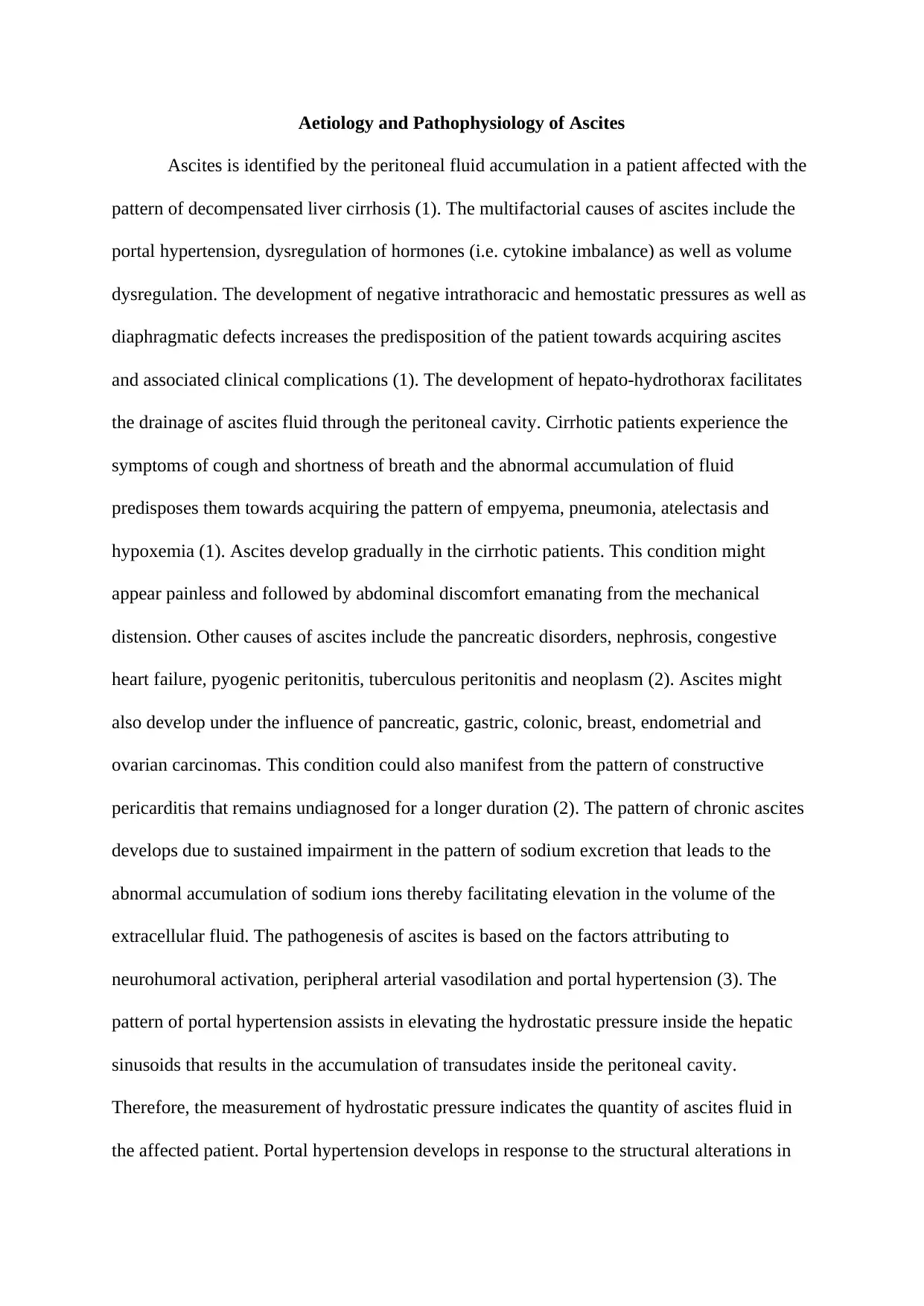
Aetiology and Pathophysiology of Ascites
Ascites is identified by the peritoneal fluid accumulation in a patient affected with the
pattern of decompensated liver cirrhosis (1). The multifactorial causes of ascites include the
portal hypertension, dysregulation of hormones (i.e. cytokine imbalance) as well as volume
dysregulation. The development of negative intrathoracic and hemostatic pressures as well as
diaphragmatic defects increases the predisposition of the patient towards acquiring ascites
and associated clinical complications (1). The development of hepato-hydrothorax facilitates
the drainage of ascites fluid through the peritoneal cavity. Cirrhotic patients experience the
symptoms of cough and shortness of breath and the abnormal accumulation of fluid
predisposes them towards acquiring the pattern of empyema, pneumonia, atelectasis and
hypoxemia (1). Ascites develop gradually in the cirrhotic patients. This condition might
appear painless and followed by abdominal discomfort emanating from the mechanical
distension. Other causes of ascites include the pancreatic disorders, nephrosis, congestive
heart failure, pyogenic peritonitis, tuberculous peritonitis and neoplasm (2). Ascites might
also develop under the influence of pancreatic, gastric, colonic, breast, endometrial and
ovarian carcinomas. This condition could also manifest from the pattern of constructive
pericarditis that remains undiagnosed for a longer duration (2). The pattern of chronic ascites
develops due to sustained impairment in the pattern of sodium excretion that leads to the
abnormal accumulation of sodium ions thereby facilitating elevation in the volume of the
extracellular fluid. The pathogenesis of ascites is based on the factors attributing to
neurohumoral activation, peripheral arterial vasodilation and portal hypertension (3). The
pattern of portal hypertension assists in elevating the hydrostatic pressure inside the hepatic
sinusoids that results in the accumulation of transudates inside the peritoneal cavity.
Therefore, the measurement of hydrostatic pressure indicates the quantity of ascites fluid in
the affected patient. Portal hypertension develops in response to the structural alterations in
Ascites is identified by the peritoneal fluid accumulation in a patient affected with the
pattern of decompensated liver cirrhosis (1). The multifactorial causes of ascites include the
portal hypertension, dysregulation of hormones (i.e. cytokine imbalance) as well as volume
dysregulation. The development of negative intrathoracic and hemostatic pressures as well as
diaphragmatic defects increases the predisposition of the patient towards acquiring ascites
and associated clinical complications (1). The development of hepato-hydrothorax facilitates
the drainage of ascites fluid through the peritoneal cavity. Cirrhotic patients experience the
symptoms of cough and shortness of breath and the abnormal accumulation of fluid
predisposes them towards acquiring the pattern of empyema, pneumonia, atelectasis and
hypoxemia (1). Ascites develop gradually in the cirrhotic patients. This condition might
appear painless and followed by abdominal discomfort emanating from the mechanical
distension. Other causes of ascites include the pancreatic disorders, nephrosis, congestive
heart failure, pyogenic peritonitis, tuberculous peritonitis and neoplasm (2). Ascites might
also develop under the influence of pancreatic, gastric, colonic, breast, endometrial and
ovarian carcinomas. This condition could also manifest from the pattern of constructive
pericarditis that remains undiagnosed for a longer duration (2). The pattern of chronic ascites
develops due to sustained impairment in the pattern of sodium excretion that leads to the
abnormal accumulation of sodium ions thereby facilitating elevation in the volume of the
extracellular fluid. The pathogenesis of ascites is based on the factors attributing to
neurohumoral activation, peripheral arterial vasodilation and portal hypertension (3). The
pattern of portal hypertension assists in elevating the hydrostatic pressure inside the hepatic
sinusoids that results in the accumulation of transudates inside the peritoneal cavity.
Therefore, the measurement of hydrostatic pressure indicates the quantity of ascites fluid in
the affected patient. Portal hypertension develops in response to the structural alterations in
Paraphrase This Document
Need a fresh take? Get an instant paraphrase of this document with our AI Paraphraser
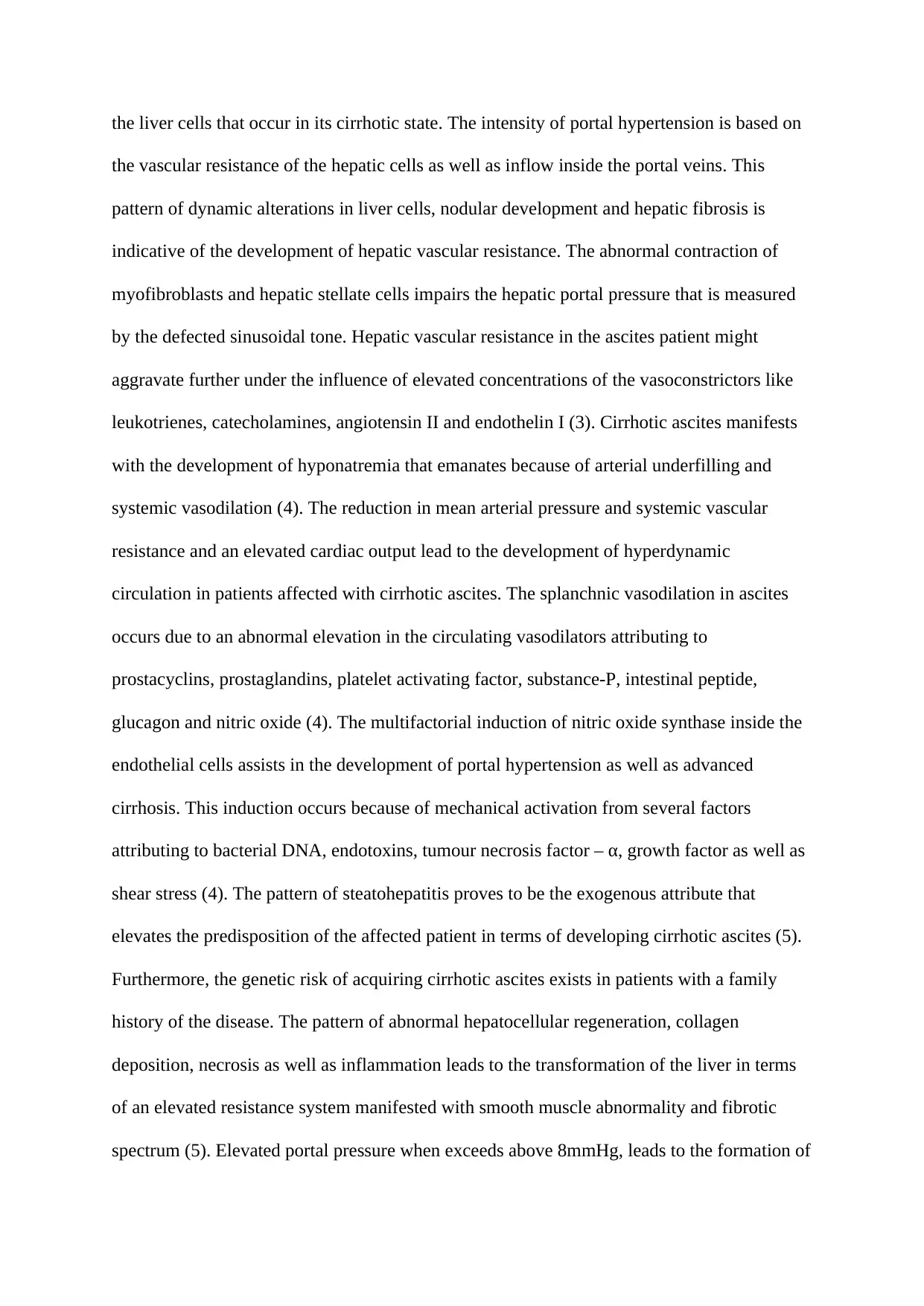
the liver cells that occur in its cirrhotic state. The intensity of portal hypertension is based on
the vascular resistance of the hepatic cells as well as inflow inside the portal veins. This
pattern of dynamic alterations in liver cells, nodular development and hepatic fibrosis is
indicative of the development of hepatic vascular resistance. The abnormal contraction of
myofibroblasts and hepatic stellate cells impairs the hepatic portal pressure that is measured
by the defected sinusoidal tone. Hepatic vascular resistance in the ascites patient might
aggravate further under the influence of elevated concentrations of the vasoconstrictors like
leukotrienes, catecholamines, angiotensin II and endothelin I (3). Cirrhotic ascites manifests
with the development of hyponatremia that emanates because of arterial underfilling and
systemic vasodilation (4). The reduction in mean arterial pressure and systemic vascular
resistance and an elevated cardiac output lead to the development of hyperdynamic
circulation in patients affected with cirrhotic ascites. The splanchnic vasodilation in ascites
occurs due to an abnormal elevation in the circulating vasodilators attributing to
prostacyclins, prostaglandins, platelet activating factor, substance-P, intestinal peptide,
glucagon and nitric oxide (4). The multifactorial induction of nitric oxide synthase inside the
endothelial cells assists in the development of portal hypertension as well as advanced
cirrhosis. This induction occurs because of mechanical activation from several factors
attributing to bacterial DNA, endotoxins, tumour necrosis factor – α, growth factor as well as
shear stress (4). The pattern of steatohepatitis proves to be the exogenous attribute that
elevates the predisposition of the affected patient in terms of developing cirrhotic ascites (5).
Furthermore, the genetic risk of acquiring cirrhotic ascites exists in patients with a family
history of the disease. The pattern of abnormal hepatocellular regeneration, collagen
deposition, necrosis as well as inflammation leads to the transformation of the liver in terms
of an elevated resistance system manifested with smooth muscle abnormality and fibrotic
spectrum (5). Elevated portal pressure when exceeds above 8mmHg, leads to the formation of
the vascular resistance of the hepatic cells as well as inflow inside the portal veins. This
pattern of dynamic alterations in liver cells, nodular development and hepatic fibrosis is
indicative of the development of hepatic vascular resistance. The abnormal contraction of
myofibroblasts and hepatic stellate cells impairs the hepatic portal pressure that is measured
by the defected sinusoidal tone. Hepatic vascular resistance in the ascites patient might
aggravate further under the influence of elevated concentrations of the vasoconstrictors like
leukotrienes, catecholamines, angiotensin II and endothelin I (3). Cirrhotic ascites manifests
with the development of hyponatremia that emanates because of arterial underfilling and
systemic vasodilation (4). The reduction in mean arterial pressure and systemic vascular
resistance and an elevated cardiac output lead to the development of hyperdynamic
circulation in patients affected with cirrhotic ascites. The splanchnic vasodilation in ascites
occurs due to an abnormal elevation in the circulating vasodilators attributing to
prostacyclins, prostaglandins, platelet activating factor, substance-P, intestinal peptide,
glucagon and nitric oxide (4). The multifactorial induction of nitric oxide synthase inside the
endothelial cells assists in the development of portal hypertension as well as advanced
cirrhosis. This induction occurs because of mechanical activation from several factors
attributing to bacterial DNA, endotoxins, tumour necrosis factor – α, growth factor as well as
shear stress (4). The pattern of steatohepatitis proves to be the exogenous attribute that
elevates the predisposition of the affected patient in terms of developing cirrhotic ascites (5).
Furthermore, the genetic risk of acquiring cirrhotic ascites exists in patients with a family
history of the disease. The pattern of abnormal hepatocellular regeneration, collagen
deposition, necrosis as well as inflammation leads to the transformation of the liver in terms
of an elevated resistance system manifested with smooth muscle abnormality and fibrotic
spectrum (5). Elevated portal pressure when exceeds above 8mmHg, leads to the formation of
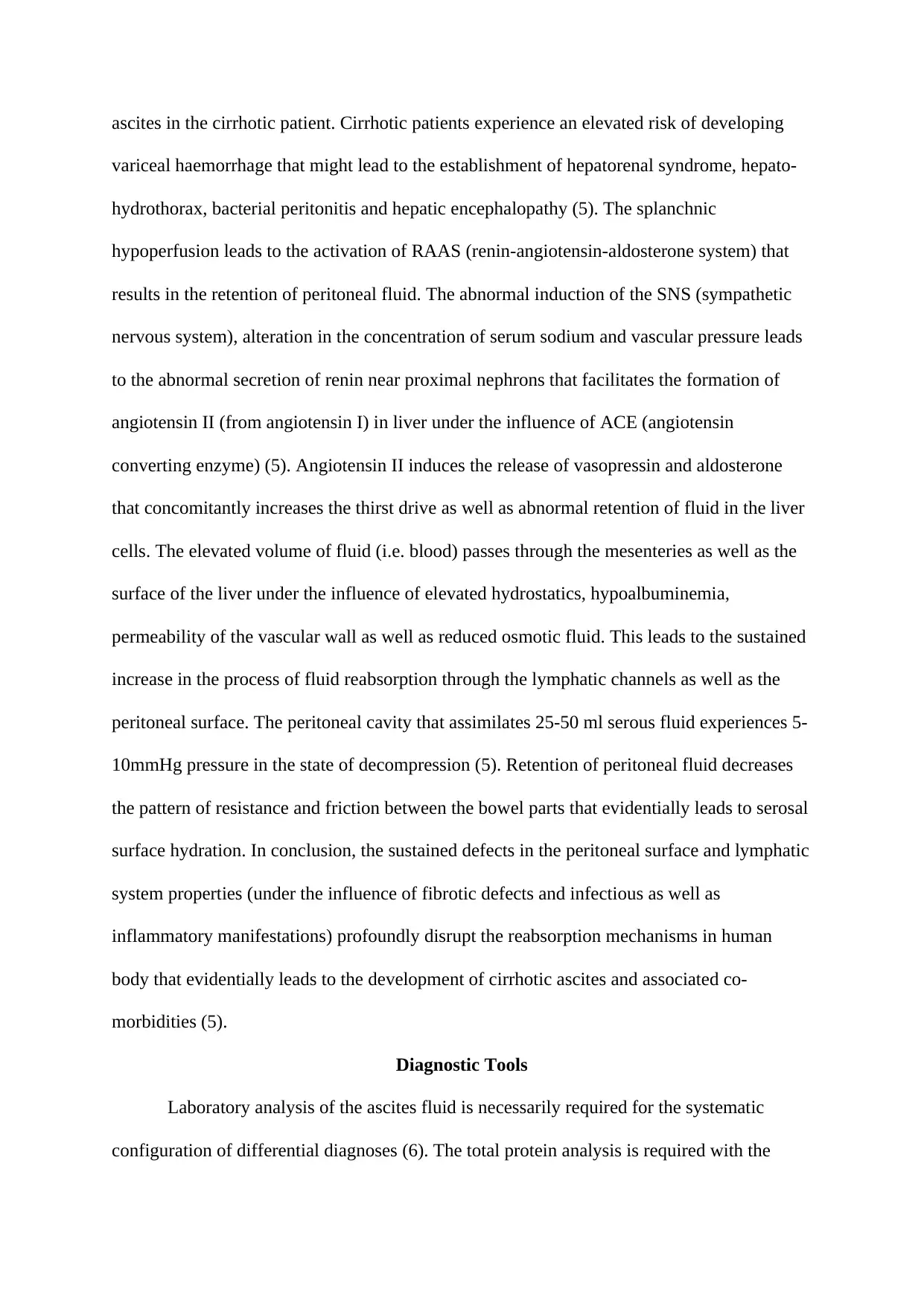
ascites in the cirrhotic patient. Cirrhotic patients experience an elevated risk of developing
variceal haemorrhage that might lead to the establishment of hepatorenal syndrome, hepato-
hydrothorax, bacterial peritonitis and hepatic encephalopathy (5). The splanchnic
hypoperfusion leads to the activation of RAAS (renin-angiotensin-aldosterone system) that
results in the retention of peritoneal fluid. The abnormal induction of the SNS (sympathetic
nervous system), alteration in the concentration of serum sodium and vascular pressure leads
to the abnormal secretion of renin near proximal nephrons that facilitates the formation of
angiotensin II (from angiotensin I) in liver under the influence of ACE (angiotensin
converting enzyme) (5). Angiotensin II induces the release of vasopressin and aldosterone
that concomitantly increases the thirst drive as well as abnormal retention of fluid in the liver
cells. The elevated volume of fluid (i.e. blood) passes through the mesenteries as well as the
surface of the liver under the influence of elevated hydrostatics, hypoalbuminemia,
permeability of the vascular wall as well as reduced osmotic fluid. This leads to the sustained
increase in the process of fluid reabsorption through the lymphatic channels as well as the
peritoneal surface. The peritoneal cavity that assimilates 25-50 ml serous fluid experiences 5-
10mmHg pressure in the state of decompression (5). Retention of peritoneal fluid decreases
the pattern of resistance and friction between the bowel parts that evidentially leads to serosal
surface hydration. In conclusion, the sustained defects in the peritoneal surface and lymphatic
system properties (under the influence of fibrotic defects and infectious as well as
inflammatory manifestations) profoundly disrupt the reabsorption mechanisms in human
body that evidentially leads to the development of cirrhotic ascites and associated co-
morbidities (5).
Diagnostic Tools
Laboratory analysis of the ascites fluid is necessarily required for the systematic
configuration of differential diagnoses (6). The total protein analysis is required with the
variceal haemorrhage that might lead to the establishment of hepatorenal syndrome, hepato-
hydrothorax, bacterial peritonitis and hepatic encephalopathy (5). The splanchnic
hypoperfusion leads to the activation of RAAS (renin-angiotensin-aldosterone system) that
results in the retention of peritoneal fluid. The abnormal induction of the SNS (sympathetic
nervous system), alteration in the concentration of serum sodium and vascular pressure leads
to the abnormal secretion of renin near proximal nephrons that facilitates the formation of
angiotensin II (from angiotensin I) in liver under the influence of ACE (angiotensin
converting enzyme) (5). Angiotensin II induces the release of vasopressin and aldosterone
that concomitantly increases the thirst drive as well as abnormal retention of fluid in the liver
cells. The elevated volume of fluid (i.e. blood) passes through the mesenteries as well as the
surface of the liver under the influence of elevated hydrostatics, hypoalbuminemia,
permeability of the vascular wall as well as reduced osmotic fluid. This leads to the sustained
increase in the process of fluid reabsorption through the lymphatic channels as well as the
peritoneal surface. The peritoneal cavity that assimilates 25-50 ml serous fluid experiences 5-
10mmHg pressure in the state of decompression (5). Retention of peritoneal fluid decreases
the pattern of resistance and friction between the bowel parts that evidentially leads to serosal
surface hydration. In conclusion, the sustained defects in the peritoneal surface and lymphatic
system properties (under the influence of fibrotic defects and infectious as well as
inflammatory manifestations) profoundly disrupt the reabsorption mechanisms in human
body that evidentially leads to the development of cirrhotic ascites and associated co-
morbidities (5).
Diagnostic Tools
Laboratory analysis of the ascites fluid is necessarily required for the systematic
configuration of differential diagnoses (6). The total protein analysis is required with the
⊘ This is a preview!⊘
Do you want full access?
Subscribe today to unlock all pages.

Trusted by 1+ million students worldwide
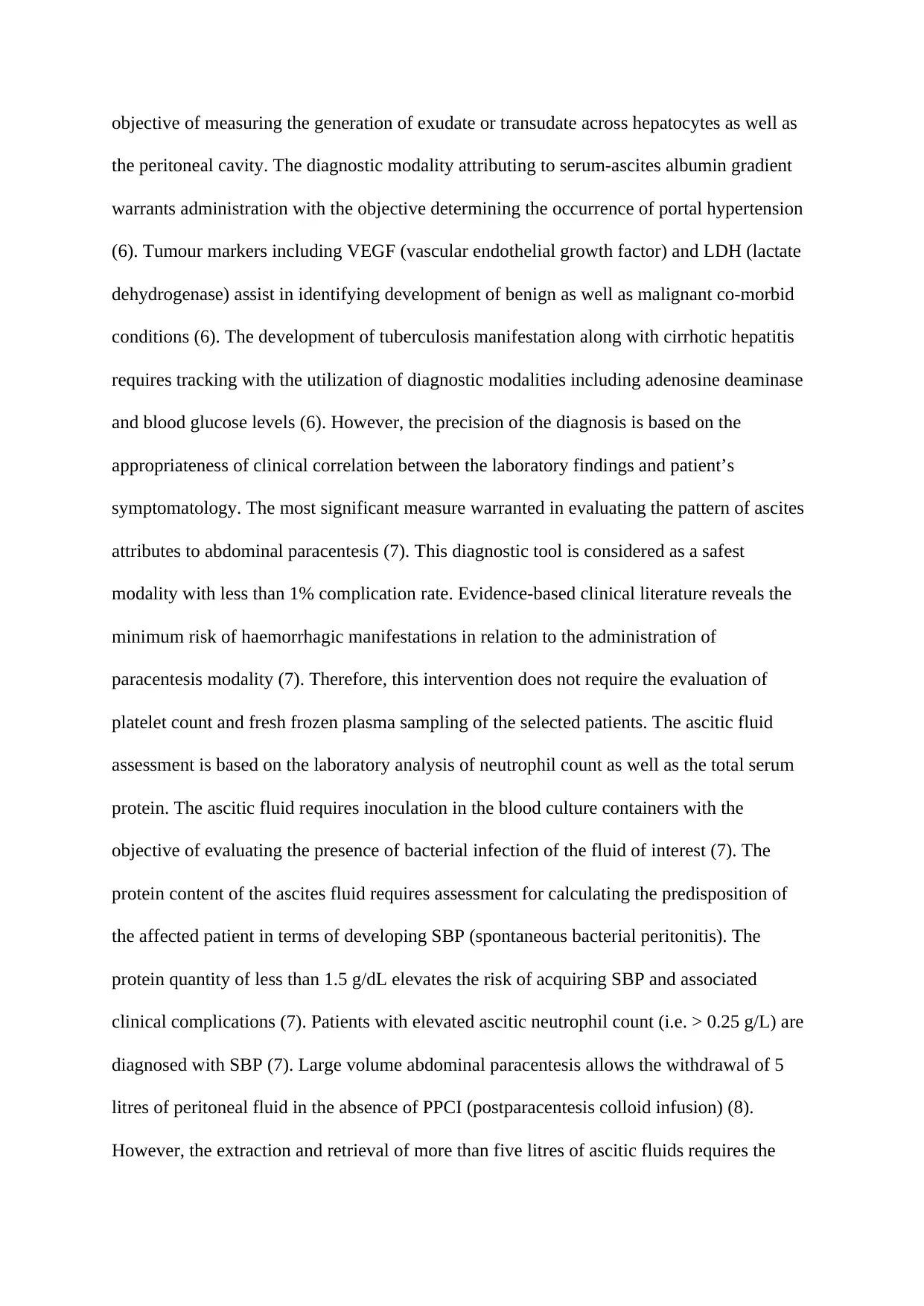
objective of measuring the generation of exudate or transudate across hepatocytes as well as
the peritoneal cavity. The diagnostic modality attributing to serum-ascites albumin gradient
warrants administration with the objective determining the occurrence of portal hypertension
(6). Tumour markers including VEGF (vascular endothelial growth factor) and LDH (lactate
dehydrogenase) assist in identifying development of benign as well as malignant co-morbid
conditions (6). The development of tuberculosis manifestation along with cirrhotic hepatitis
requires tracking with the utilization of diagnostic modalities including adenosine deaminase
and blood glucose levels (6). However, the precision of the diagnosis is based on the
appropriateness of clinical correlation between the laboratory findings and patient’s
symptomatology. The most significant measure warranted in evaluating the pattern of ascites
attributes to abdominal paracentesis (7). This diagnostic tool is considered as a safest
modality with less than 1% complication rate. Evidence-based clinical literature reveals the
minimum risk of haemorrhagic manifestations in relation to the administration of
paracentesis modality (7). Therefore, this intervention does not require the evaluation of
platelet count and fresh frozen plasma sampling of the selected patients. The ascitic fluid
assessment is based on the laboratory analysis of neutrophil count as well as the total serum
protein. The ascitic fluid requires inoculation in the blood culture containers with the
objective of evaluating the presence of bacterial infection of the fluid of interest (7). The
protein content of the ascites fluid requires assessment for calculating the predisposition of
the affected patient in terms of developing SBP (spontaneous bacterial peritonitis). The
protein quantity of less than 1.5 g/dL elevates the risk of acquiring SBP and associated
clinical complications (7). Patients with elevated ascitic neutrophil count (i.e. > 0.25 g/L) are
diagnosed with SBP (7). Large volume abdominal paracentesis allows the withdrawal of 5
litres of peritoneal fluid in the absence of PPCI (postparacentesis colloid infusion) (8).
However, the extraction and retrieval of more than five litres of ascitic fluids requires the
the peritoneal cavity. The diagnostic modality attributing to serum-ascites albumin gradient
warrants administration with the objective determining the occurrence of portal hypertension
(6). Tumour markers including VEGF (vascular endothelial growth factor) and LDH (lactate
dehydrogenase) assist in identifying development of benign as well as malignant co-morbid
conditions (6). The development of tuberculosis manifestation along with cirrhotic hepatitis
requires tracking with the utilization of diagnostic modalities including adenosine deaminase
and blood glucose levels (6). However, the precision of the diagnosis is based on the
appropriateness of clinical correlation between the laboratory findings and patient’s
symptomatology. The most significant measure warranted in evaluating the pattern of ascites
attributes to abdominal paracentesis (7). This diagnostic tool is considered as a safest
modality with less than 1% complication rate. Evidence-based clinical literature reveals the
minimum risk of haemorrhagic manifestations in relation to the administration of
paracentesis modality (7). Therefore, this intervention does not require the evaluation of
platelet count and fresh frozen plasma sampling of the selected patients. The ascitic fluid
assessment is based on the laboratory analysis of neutrophil count as well as the total serum
protein. The ascitic fluid requires inoculation in the blood culture containers with the
objective of evaluating the presence of bacterial infection of the fluid of interest (7). The
protein content of the ascites fluid requires assessment for calculating the predisposition of
the affected patient in terms of developing SBP (spontaneous bacterial peritonitis). The
protein quantity of less than 1.5 g/dL elevates the risk of acquiring SBP and associated
clinical complications (7). Patients with elevated ascitic neutrophil count (i.e. > 0.25 g/L) are
diagnosed with SBP (7). Large volume abdominal paracentesis allows the withdrawal of 5
litres of peritoneal fluid in the absence of PPCI (postparacentesis colloid infusion) (8).
However, the extraction and retrieval of more than five litres of ascitic fluids requires the
Paraphrase This Document
Need a fresh take? Get an instant paraphrase of this document with our AI Paraphraser
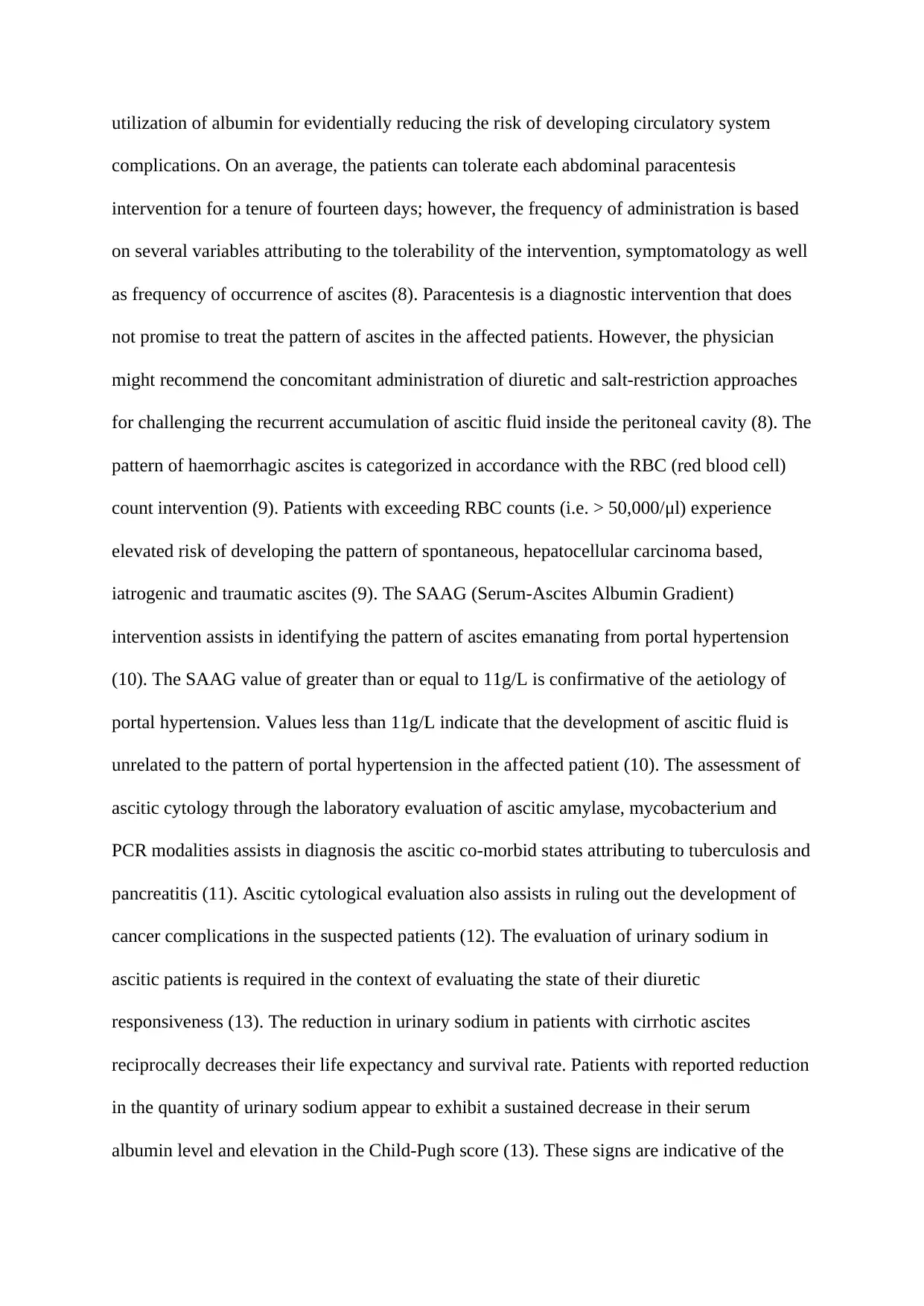
utilization of albumin for evidentially reducing the risk of developing circulatory system
complications. On an average, the patients can tolerate each abdominal paracentesis
intervention for a tenure of fourteen days; however, the frequency of administration is based
on several variables attributing to the tolerability of the intervention, symptomatology as well
as frequency of occurrence of ascites (8). Paracentesis is a diagnostic intervention that does
not promise to treat the pattern of ascites in the affected patients. However, the physician
might recommend the concomitant administration of diuretic and salt-restriction approaches
for challenging the recurrent accumulation of ascitic fluid inside the peritoneal cavity (8). The
pattern of haemorrhagic ascites is categorized in accordance with the RBC (red blood cell)
count intervention (9). Patients with exceeding RBC counts (i.e. > 50,000/μl) experience
elevated risk of developing the pattern of spontaneous, hepatocellular carcinoma based,
iatrogenic and traumatic ascites (9). The SAAG (Serum-Ascites Albumin Gradient)
intervention assists in identifying the pattern of ascites emanating from portal hypertension
(10). The SAAG value of greater than or equal to 11g/L is confirmative of the aetiology of
portal hypertension. Values less than 11g/L indicate that the development of ascitic fluid is
unrelated to the pattern of portal hypertension in the affected patient (10). The assessment of
ascitic cytology through the laboratory evaluation of ascitic amylase, mycobacterium and
PCR modalities assists in diagnosis the ascitic co-morbid states attributing to tuberculosis and
pancreatitis (11). Ascitic cytological evaluation also assists in ruling out the development of
cancer complications in the suspected patients (12). The evaluation of urinary sodium in
ascitic patients is required in the context of evaluating the state of their diuretic
responsiveness (13). The reduction in urinary sodium in patients with cirrhotic ascites
reciprocally decreases their life expectancy and survival rate. Patients with reported reduction
in the quantity of urinary sodium appear to exhibit a sustained decrease in their serum
albumin level and elevation in the Child-Pugh score (13). These signs are indicative of the
complications. On an average, the patients can tolerate each abdominal paracentesis
intervention for a tenure of fourteen days; however, the frequency of administration is based
on several variables attributing to the tolerability of the intervention, symptomatology as well
as frequency of occurrence of ascites (8). Paracentesis is a diagnostic intervention that does
not promise to treat the pattern of ascites in the affected patients. However, the physician
might recommend the concomitant administration of diuretic and salt-restriction approaches
for challenging the recurrent accumulation of ascitic fluid inside the peritoneal cavity (8). The
pattern of haemorrhagic ascites is categorized in accordance with the RBC (red blood cell)
count intervention (9). Patients with exceeding RBC counts (i.e. > 50,000/μl) experience
elevated risk of developing the pattern of spontaneous, hepatocellular carcinoma based,
iatrogenic and traumatic ascites (9). The SAAG (Serum-Ascites Albumin Gradient)
intervention assists in identifying the pattern of ascites emanating from portal hypertension
(10). The SAAG value of greater than or equal to 11g/L is confirmative of the aetiology of
portal hypertension. Values less than 11g/L indicate that the development of ascitic fluid is
unrelated to the pattern of portal hypertension in the affected patient (10). The assessment of
ascitic cytology through the laboratory evaluation of ascitic amylase, mycobacterium and
PCR modalities assists in diagnosis the ascitic co-morbid states attributing to tuberculosis and
pancreatitis (11). Ascitic cytological evaluation also assists in ruling out the development of
cancer complications in the suspected patients (12). The evaluation of urinary sodium in
ascitic patients is required in the context of evaluating the state of their diuretic
responsiveness (13). The reduction in urinary sodium in patients with cirrhotic ascites
reciprocally decreases their life expectancy and survival rate. Patients with reported reduction
in the quantity of urinary sodium appear to exhibit a sustained decrease in their serum
albumin level and elevation in the Child-Pugh score (13). These signs are indicative of the
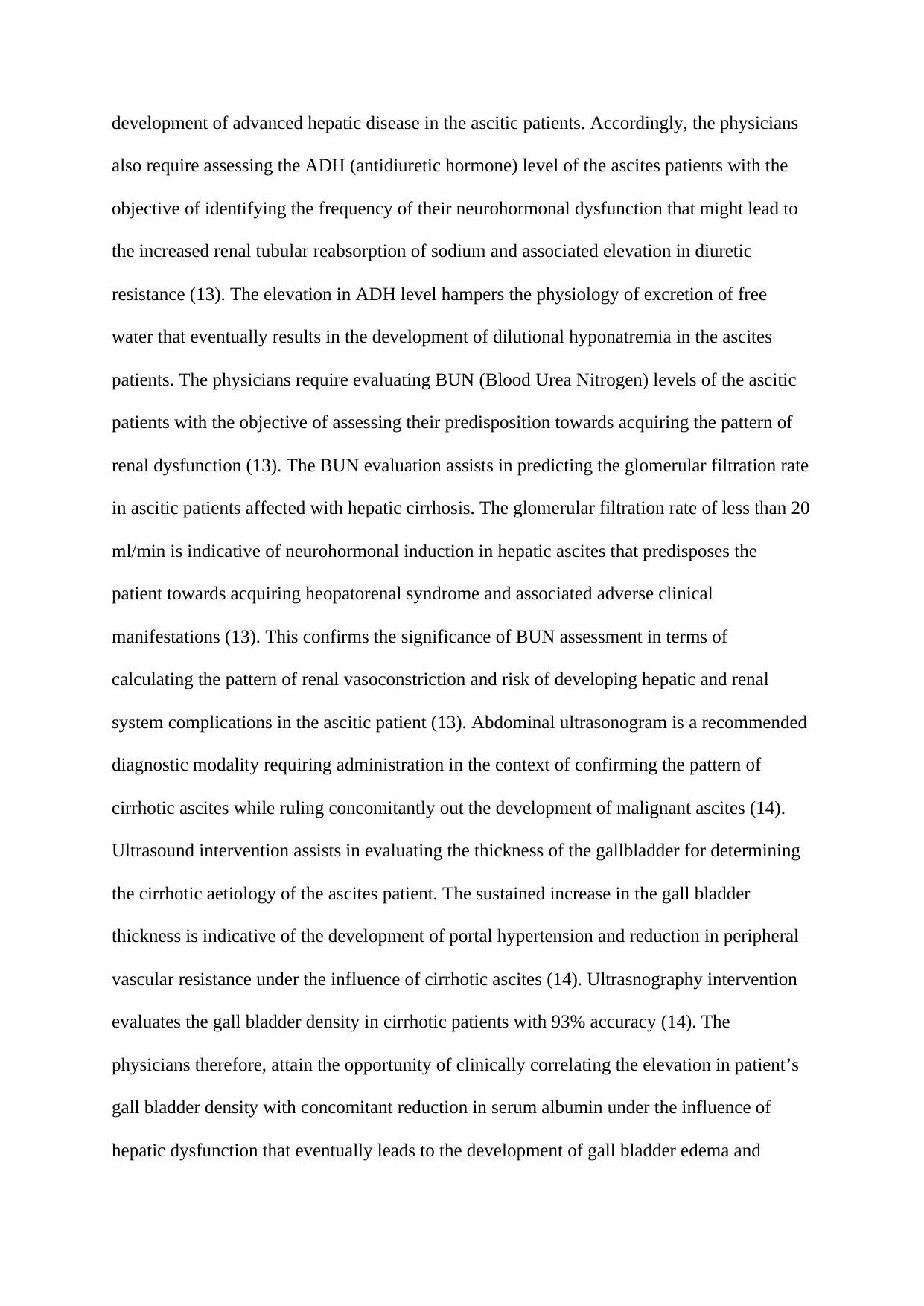
development of advanced hepatic disease in the ascitic patients. Accordingly, the physicians
also require assessing the ADH (antidiuretic hormone) level of the ascites patients with the
objective of identifying the frequency of their neurohormonal dysfunction that might lead to
the increased renal tubular reabsorption of sodium and associated elevation in diuretic
resistance (13). The elevation in ADH level hampers the physiology of excretion of free
water that eventually results in the development of dilutional hyponatremia in the ascites
patients. The physicians require evaluating BUN (Blood Urea Nitrogen) levels of the ascitic
patients with the objective of assessing their predisposition towards acquiring the pattern of
renal dysfunction (13). The BUN evaluation assists in predicting the glomerular filtration rate
in ascitic patients affected with hepatic cirrhosis. The glomerular filtration rate of less than 20
ml/min is indicative of neurohormonal induction in hepatic ascites that predisposes the
patient towards acquiring heopatorenal syndrome and associated adverse clinical
manifestations (13). This confirms the significance of BUN assessment in terms of
calculating the pattern of renal vasoconstriction and risk of developing hepatic and renal
system complications in the ascitic patient (13). Abdominal ultrasonogram is a recommended
diagnostic modality requiring administration in the context of confirming the pattern of
cirrhotic ascites while ruling concomitantly out the development of malignant ascites (14).
Ultrasound intervention assists in evaluating the thickness of the gallbladder for determining
the cirrhotic aetiology of the ascites patient. The sustained increase in the gall bladder
thickness is indicative of the development of portal hypertension and reduction in peripheral
vascular resistance under the influence of cirrhotic ascites (14). Ultrasnography intervention
evaluates the gall bladder density in cirrhotic patients with 93% accuracy (14). The
physicians therefore, attain the opportunity of clinically correlating the elevation in patient’s
gall bladder density with concomitant reduction in serum albumin under the influence of
hepatic dysfunction that eventually leads to the development of gall bladder edema and
also require assessing the ADH (antidiuretic hormone) level of the ascites patients with the
objective of identifying the frequency of their neurohormonal dysfunction that might lead to
the increased renal tubular reabsorption of sodium and associated elevation in diuretic
resistance (13). The elevation in ADH level hampers the physiology of excretion of free
water that eventually results in the development of dilutional hyponatremia in the ascites
patients. The physicians require evaluating BUN (Blood Urea Nitrogen) levels of the ascitic
patients with the objective of assessing their predisposition towards acquiring the pattern of
renal dysfunction (13). The BUN evaluation assists in predicting the glomerular filtration rate
in ascitic patients affected with hepatic cirrhosis. The glomerular filtration rate of less than 20
ml/min is indicative of neurohormonal induction in hepatic ascites that predisposes the
patient towards acquiring heopatorenal syndrome and associated adverse clinical
manifestations (13). This confirms the significance of BUN assessment in terms of
calculating the pattern of renal vasoconstriction and risk of developing hepatic and renal
system complications in the ascitic patient (13). Abdominal ultrasonogram is a recommended
diagnostic modality requiring administration in the context of confirming the pattern of
cirrhotic ascites while ruling concomitantly out the development of malignant ascites (14).
Ultrasound intervention assists in evaluating the thickness of the gallbladder for determining
the cirrhotic aetiology of the ascites patient. The sustained increase in the gall bladder
thickness is indicative of the development of portal hypertension and reduction in peripheral
vascular resistance under the influence of cirrhotic ascites (14). Ultrasnography intervention
evaluates the gall bladder density in cirrhotic patients with 93% accuracy (14). The
physicians therefore, attain the opportunity of clinically correlating the elevation in patient’s
gall bladder density with concomitant reduction in serum albumin under the influence of
hepatic dysfunction that eventually leads to the development of gall bladder edema and
⊘ This is a preview!⊘
Do you want full access?
Subscribe today to unlock all pages.

Trusted by 1+ million students worldwide
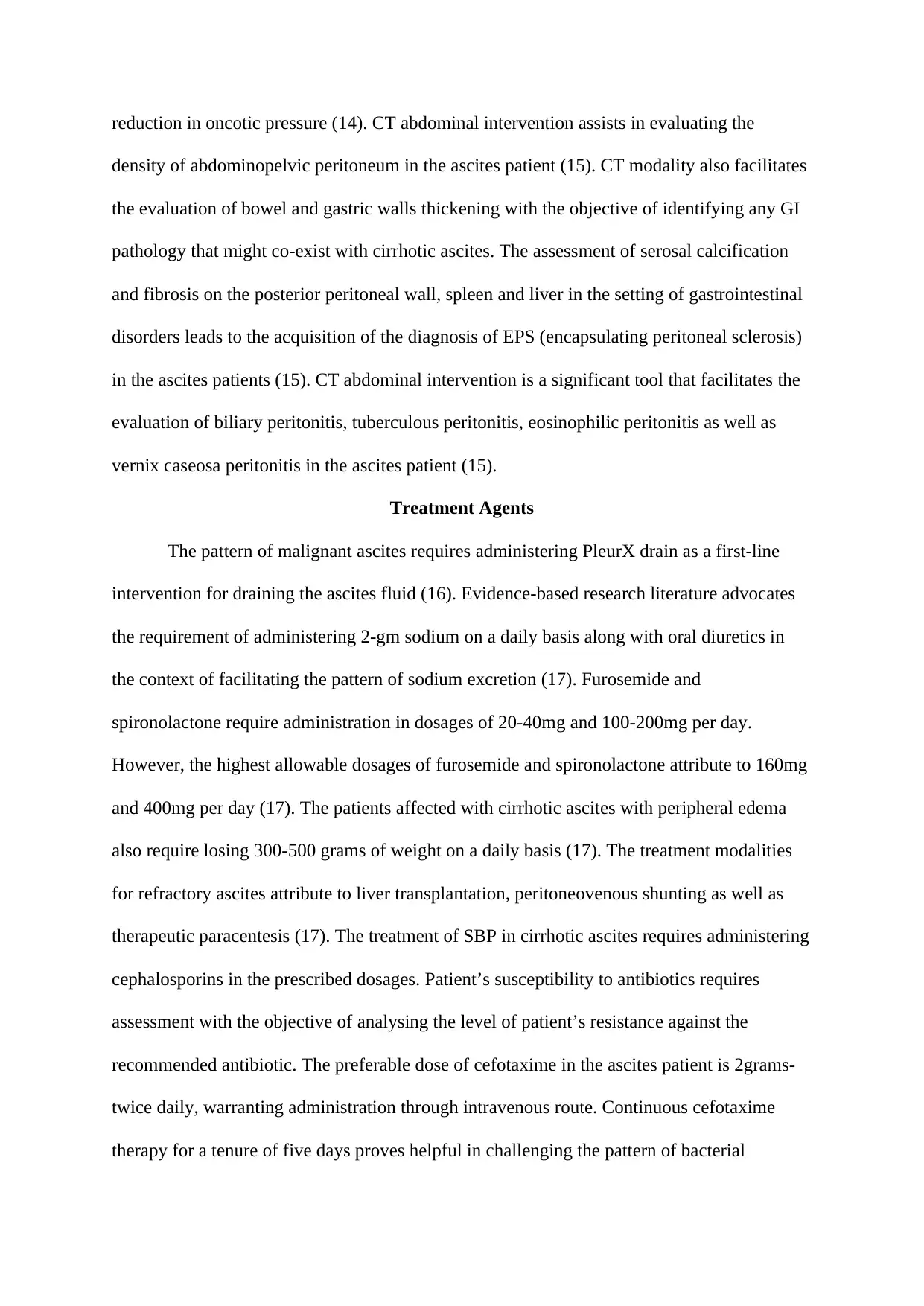
reduction in oncotic pressure (14). CT abdominal intervention assists in evaluating the
density of abdominopelvic peritoneum in the ascites patient (15). CT modality also facilitates
the evaluation of bowel and gastric walls thickening with the objective of identifying any GI
pathology that might co-exist with cirrhotic ascites. The assessment of serosal calcification
and fibrosis on the posterior peritoneal wall, spleen and liver in the setting of gastrointestinal
disorders leads to the acquisition of the diagnosis of EPS (encapsulating peritoneal sclerosis)
in the ascites patients (15). CT abdominal intervention is a significant tool that facilitates the
evaluation of biliary peritonitis, tuberculous peritonitis, eosinophilic peritonitis as well as
vernix caseosa peritonitis in the ascites patient (15).
Treatment Agents
The pattern of malignant ascites requires administering PleurX drain as a first-line
intervention for draining the ascites fluid (16). Evidence-based research literature advocates
the requirement of administering 2-gm sodium on a daily basis along with oral diuretics in
the context of facilitating the pattern of sodium excretion (17). Furosemide and
spironolactone require administration in dosages of 20-40mg and 100-200mg per day.
However, the highest allowable dosages of furosemide and spironolactone attribute to 160mg
and 400mg per day (17). The patients affected with cirrhotic ascites with peripheral edema
also require losing 300-500 grams of weight on a daily basis (17). The treatment modalities
for refractory ascites attribute to liver transplantation, peritoneovenous shunting as well as
therapeutic paracentesis (17). The treatment of SBP in cirrhotic ascites requires administering
cephalosporins in the prescribed dosages. Patient’s susceptibility to antibiotics requires
assessment with the objective of analysing the level of patient’s resistance against the
recommended antibiotic. The preferable dose of cefotaxime in the ascites patient is 2grams-
twice daily, warranting administration through intravenous route. Continuous cefotaxime
therapy for a tenure of five days proves helpful in challenging the pattern of bacterial
density of abdominopelvic peritoneum in the ascites patient (15). CT modality also facilitates
the evaluation of bowel and gastric walls thickening with the objective of identifying any GI
pathology that might co-exist with cirrhotic ascites. The assessment of serosal calcification
and fibrosis on the posterior peritoneal wall, spleen and liver in the setting of gastrointestinal
disorders leads to the acquisition of the diagnosis of EPS (encapsulating peritoneal sclerosis)
in the ascites patients (15). CT abdominal intervention is a significant tool that facilitates the
evaluation of biliary peritonitis, tuberculous peritonitis, eosinophilic peritonitis as well as
vernix caseosa peritonitis in the ascites patient (15).
Treatment Agents
The pattern of malignant ascites requires administering PleurX drain as a first-line
intervention for draining the ascites fluid (16). Evidence-based research literature advocates
the requirement of administering 2-gm sodium on a daily basis along with oral diuretics in
the context of facilitating the pattern of sodium excretion (17). Furosemide and
spironolactone require administration in dosages of 20-40mg and 100-200mg per day.
However, the highest allowable dosages of furosemide and spironolactone attribute to 160mg
and 400mg per day (17). The patients affected with cirrhotic ascites with peripheral edema
also require losing 300-500 grams of weight on a daily basis (17). The treatment modalities
for refractory ascites attribute to liver transplantation, peritoneovenous shunting as well as
therapeutic paracentesis (17). The treatment of SBP in cirrhotic ascites requires administering
cephalosporins in the prescribed dosages. Patient’s susceptibility to antibiotics requires
assessment with the objective of analysing the level of patient’s resistance against the
recommended antibiotic. The preferable dose of cefotaxime in the ascites patient is 2grams-
twice daily, warranting administration through intravenous route. Continuous cefotaxime
therapy for a tenure of five days proves helpful in challenging the pattern of bacterial
Paraphrase This Document
Need a fresh take? Get an instant paraphrase of this document with our AI Paraphraser
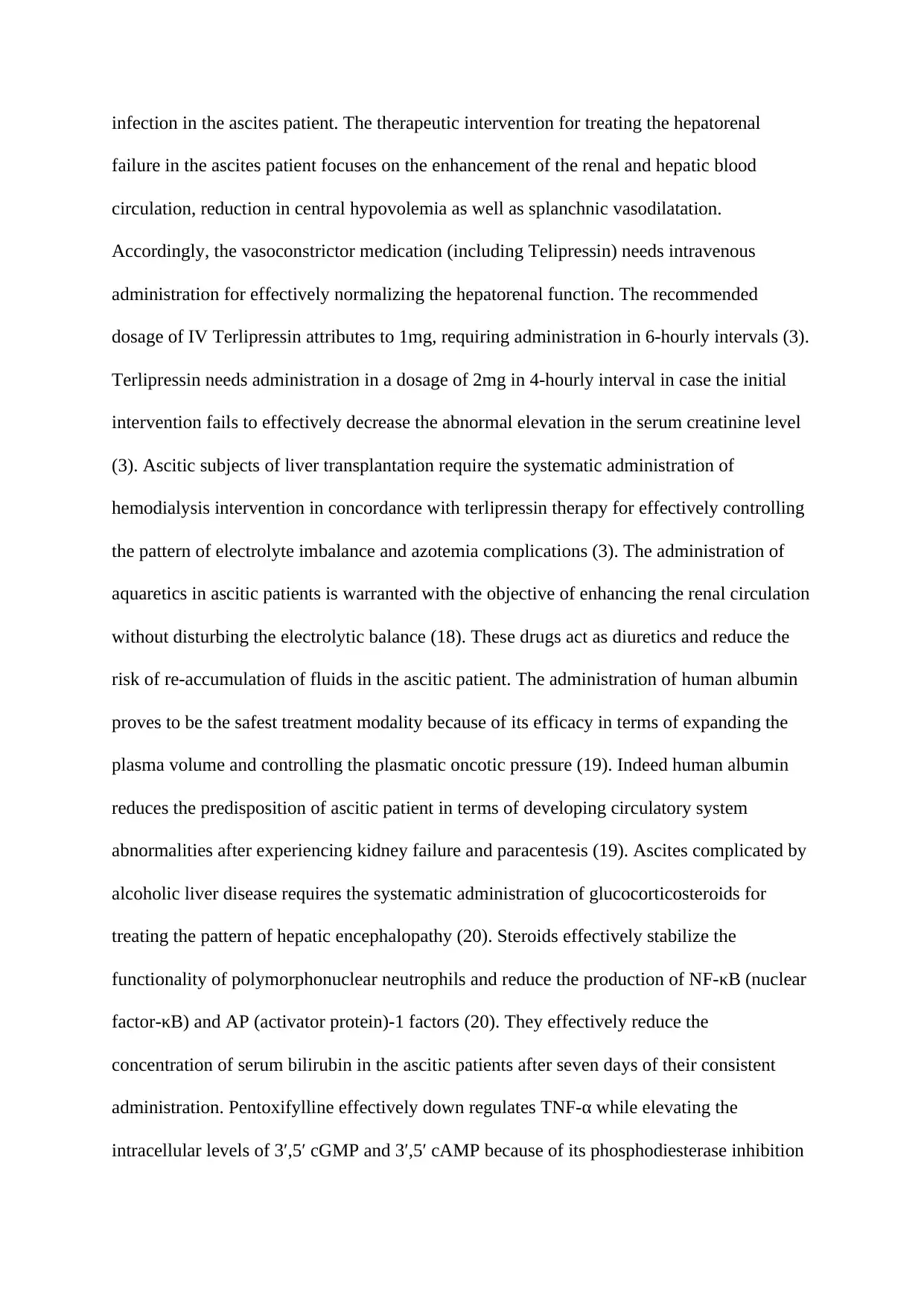
infection in the ascites patient. The therapeutic intervention for treating the hepatorenal
failure in the ascites patient focuses on the enhancement of the renal and hepatic blood
circulation, reduction in central hypovolemia as well as splanchnic vasodilatation.
Accordingly, the vasoconstrictor medication (including Telipressin) needs intravenous
administration for effectively normalizing the hepatorenal function. The recommended
dosage of IV Terlipressin attributes to 1mg, requiring administration in 6-hourly intervals (3).
Terlipressin needs administration in a dosage of 2mg in 4-hourly interval in case the initial
intervention fails to effectively decrease the abnormal elevation in the serum creatinine level
(3). Ascitic subjects of liver transplantation require the systematic administration of
hemodialysis intervention in concordance with terlipressin therapy for effectively controlling
the pattern of electrolyte imbalance and azotemia complications (3). The administration of
aquaretics in ascitic patients is warranted with the objective of enhancing the renal circulation
without disturbing the electrolytic balance (18). These drugs act as diuretics and reduce the
risk of re-accumulation of fluids in the ascitic patient. The administration of human albumin
proves to be the safest treatment modality because of its efficacy in terms of expanding the
plasma volume and controlling the plasmatic oncotic pressure (19). Indeed human albumin
reduces the predisposition of ascitic patient in terms of developing circulatory system
abnormalities after experiencing kidney failure and paracentesis (19). Ascites complicated by
alcoholic liver disease requires the systematic administration of glucocorticosteroids for
treating the pattern of hepatic encephalopathy (20). Steroids effectively stabilize the
functionality of polymorphonuclear neutrophils and reduce the production of NF-κB (nuclear
factor-κB) and AP (activator protein)-1 factors (20). They effectively reduce the
concentration of serum bilirubin in the ascitic patients after seven days of their consistent
administration. Pentoxifylline effectively down regulates TNF-α while elevating the
intracellular levels of 3′,5′ cGMP and 3′,5′ cAMP because of its phosphodiesterase inhibition
failure in the ascites patient focuses on the enhancement of the renal and hepatic blood
circulation, reduction in central hypovolemia as well as splanchnic vasodilatation.
Accordingly, the vasoconstrictor medication (including Telipressin) needs intravenous
administration for effectively normalizing the hepatorenal function. The recommended
dosage of IV Terlipressin attributes to 1mg, requiring administration in 6-hourly intervals (3).
Terlipressin needs administration in a dosage of 2mg in 4-hourly interval in case the initial
intervention fails to effectively decrease the abnormal elevation in the serum creatinine level
(3). Ascitic subjects of liver transplantation require the systematic administration of
hemodialysis intervention in concordance with terlipressin therapy for effectively controlling
the pattern of electrolyte imbalance and azotemia complications (3). The administration of
aquaretics in ascitic patients is warranted with the objective of enhancing the renal circulation
without disturbing the electrolytic balance (18). These drugs act as diuretics and reduce the
risk of re-accumulation of fluids in the ascitic patient. The administration of human albumin
proves to be the safest treatment modality because of its efficacy in terms of expanding the
plasma volume and controlling the plasmatic oncotic pressure (19). Indeed human albumin
reduces the predisposition of ascitic patient in terms of developing circulatory system
abnormalities after experiencing kidney failure and paracentesis (19). Ascites complicated by
alcoholic liver disease requires the systematic administration of glucocorticosteroids for
treating the pattern of hepatic encephalopathy (20). Steroids effectively stabilize the
functionality of polymorphonuclear neutrophils and reduce the production of NF-κB (nuclear
factor-κB) and AP (activator protein)-1 factors (20). They effectively reduce the
concentration of serum bilirubin in the ascitic patients after seven days of their consistent
administration. Pentoxifylline effectively down regulates TNF-α while elevating the
intracellular levels of 3′,5′ cGMP and 3′,5′ cAMP because of its phosphodiesterase inhibition
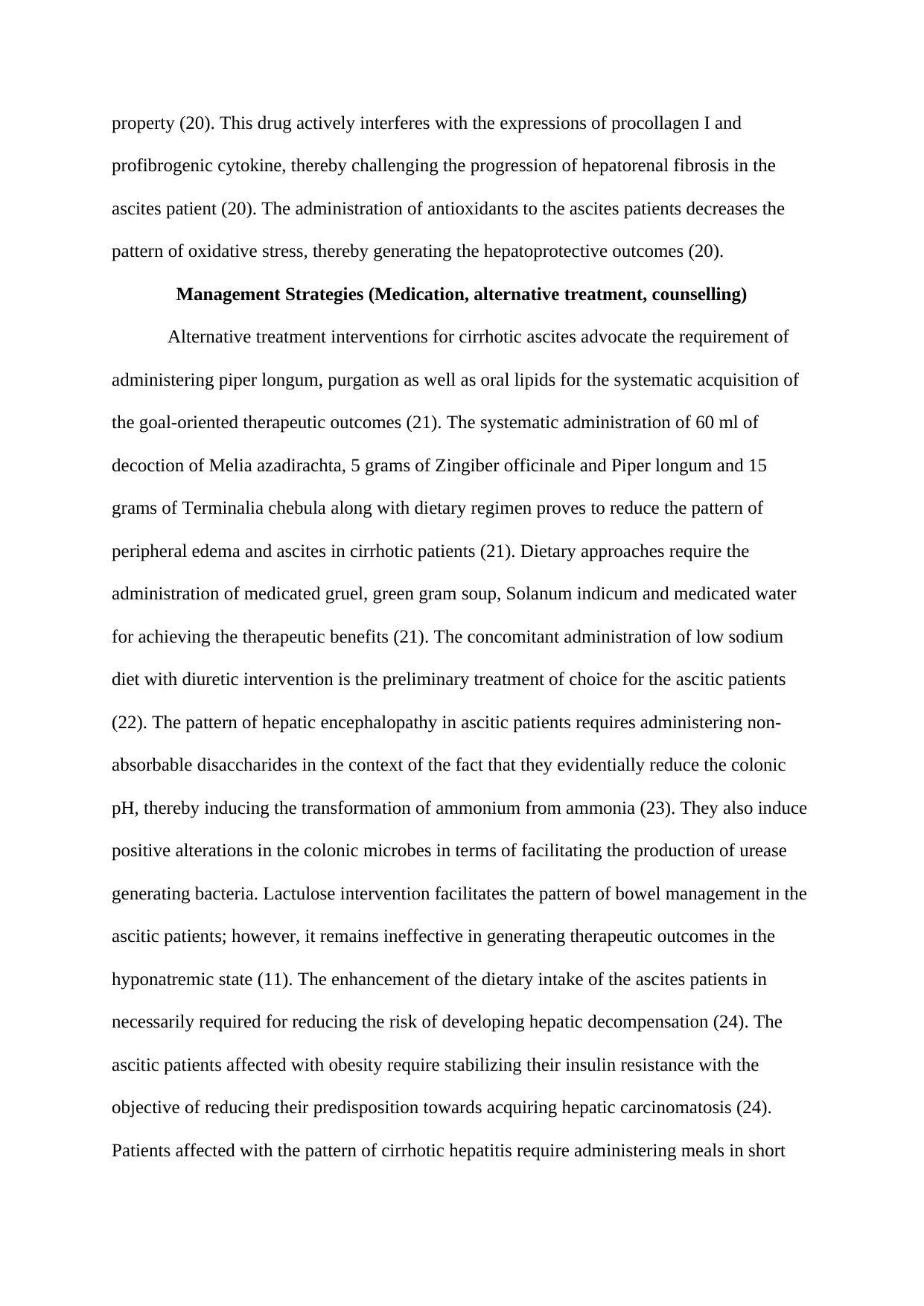
property (20). This drug actively interferes with the expressions of procollagen I and
profibrogenic cytokine, thereby challenging the progression of hepatorenal fibrosis in the
ascites patient (20). The administration of antioxidants to the ascites patients decreases the
pattern of oxidative stress, thereby generating the hepatoprotective outcomes (20).
Management Strategies (Medication, alternative treatment, counselling)
Alternative treatment interventions for cirrhotic ascites advocate the requirement of
administering piper longum, purgation as well as oral lipids for the systematic acquisition of
the goal-oriented therapeutic outcomes (21). The systematic administration of 60 ml of
decoction of Melia azadirachta, 5 grams of Zingiber officinale and Piper longum and 15
grams of Terminalia chebula along with dietary regimen proves to reduce the pattern of
peripheral edema and ascites in cirrhotic patients (21). Dietary approaches require the
administration of medicated gruel, green gram soup, Solanum indicum and medicated water
for achieving the therapeutic benefits (21). The concomitant administration of low sodium
diet with diuretic intervention is the preliminary treatment of choice for the ascitic patients
(22). The pattern of hepatic encephalopathy in ascitic patients requires administering non-
absorbable disaccharides in the context of the fact that they evidentially reduce the colonic
pH, thereby inducing the transformation of ammonium from ammonia (23). They also induce
positive alterations in the colonic microbes in terms of facilitating the production of urease
generating bacteria. Lactulose intervention facilitates the pattern of bowel management in the
ascitic patients; however, it remains ineffective in generating therapeutic outcomes in the
hyponatremic state (11). The enhancement of the dietary intake of the ascites patients in
necessarily required for reducing the risk of developing hepatic decompensation (24). The
ascitic patients affected with obesity require stabilizing their insulin resistance with the
objective of reducing their predisposition towards acquiring hepatic carcinomatosis (24).
Patients affected with the pattern of cirrhotic hepatitis require administering meals in short
profibrogenic cytokine, thereby challenging the progression of hepatorenal fibrosis in the
ascites patient (20). The administration of antioxidants to the ascites patients decreases the
pattern of oxidative stress, thereby generating the hepatoprotective outcomes (20).
Management Strategies (Medication, alternative treatment, counselling)
Alternative treatment interventions for cirrhotic ascites advocate the requirement of
administering piper longum, purgation as well as oral lipids for the systematic acquisition of
the goal-oriented therapeutic outcomes (21). The systematic administration of 60 ml of
decoction of Melia azadirachta, 5 grams of Zingiber officinale and Piper longum and 15
grams of Terminalia chebula along with dietary regimen proves to reduce the pattern of
peripheral edema and ascites in cirrhotic patients (21). Dietary approaches require the
administration of medicated gruel, green gram soup, Solanum indicum and medicated water
for achieving the therapeutic benefits (21). The concomitant administration of low sodium
diet with diuretic intervention is the preliminary treatment of choice for the ascitic patients
(22). The pattern of hepatic encephalopathy in ascitic patients requires administering non-
absorbable disaccharides in the context of the fact that they evidentially reduce the colonic
pH, thereby inducing the transformation of ammonium from ammonia (23). They also induce
positive alterations in the colonic microbes in terms of facilitating the production of urease
generating bacteria. Lactulose intervention facilitates the pattern of bowel management in the
ascitic patients; however, it remains ineffective in generating therapeutic outcomes in the
hyponatremic state (11). The enhancement of the dietary intake of the ascites patients in
necessarily required for reducing the risk of developing hepatic decompensation (24). The
ascitic patients affected with obesity require stabilizing their insulin resistance with the
objective of reducing their predisposition towards acquiring hepatic carcinomatosis (24).
Patients affected with the pattern of cirrhotic hepatitis require administering meals in short
⊘ This is a preview!⊘
Do you want full access?
Subscribe today to unlock all pages.

Trusted by 1+ million students worldwide
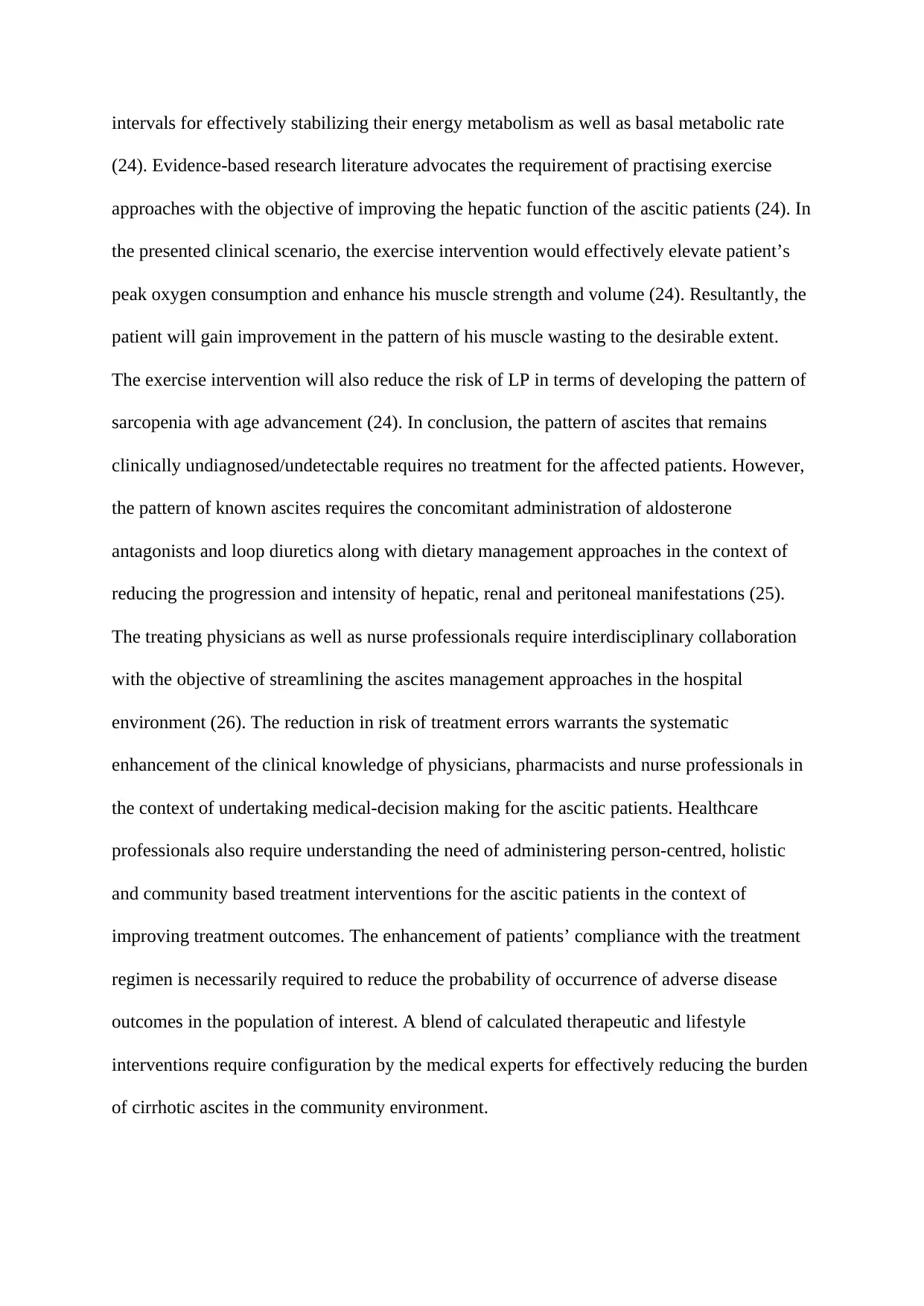
intervals for effectively stabilizing their energy metabolism as well as basal metabolic rate
(24). Evidence-based research literature advocates the requirement of practising exercise
approaches with the objective of improving the hepatic function of the ascitic patients (24). In
the presented clinical scenario, the exercise intervention would effectively elevate patient’s
peak oxygen consumption and enhance his muscle strength and volume (24). Resultantly, the
patient will gain improvement in the pattern of his muscle wasting to the desirable extent.
The exercise intervention will also reduce the risk of LP in terms of developing the pattern of
sarcopenia with age advancement (24). In conclusion, the pattern of ascites that remains
clinically undiagnosed/undetectable requires no treatment for the affected patients. However,
the pattern of known ascites requires the concomitant administration of aldosterone
antagonists and loop diuretics along with dietary management approaches in the context of
reducing the progression and intensity of hepatic, renal and peritoneal manifestations (25).
The treating physicians as well as nurse professionals require interdisciplinary collaboration
with the objective of streamlining the ascites management approaches in the hospital
environment (26). The reduction in risk of treatment errors warrants the systematic
enhancement of the clinical knowledge of physicians, pharmacists and nurse professionals in
the context of undertaking medical-decision making for the ascitic patients. Healthcare
professionals also require understanding the need of administering person-centred, holistic
and community based treatment interventions for the ascitic patients in the context of
improving treatment outcomes. The enhancement of patients’ compliance with the treatment
regimen is necessarily required to reduce the probability of occurrence of adverse disease
outcomes in the population of interest. A blend of calculated therapeutic and lifestyle
interventions require configuration by the medical experts for effectively reducing the burden
of cirrhotic ascites in the community environment.
(24). Evidence-based research literature advocates the requirement of practising exercise
approaches with the objective of improving the hepatic function of the ascitic patients (24). In
the presented clinical scenario, the exercise intervention would effectively elevate patient’s
peak oxygen consumption and enhance his muscle strength and volume (24). Resultantly, the
patient will gain improvement in the pattern of his muscle wasting to the desirable extent.
The exercise intervention will also reduce the risk of LP in terms of developing the pattern of
sarcopenia with age advancement (24). In conclusion, the pattern of ascites that remains
clinically undiagnosed/undetectable requires no treatment for the affected patients. However,
the pattern of known ascites requires the concomitant administration of aldosterone
antagonists and loop diuretics along with dietary management approaches in the context of
reducing the progression and intensity of hepatic, renal and peritoneal manifestations (25).
The treating physicians as well as nurse professionals require interdisciplinary collaboration
with the objective of streamlining the ascites management approaches in the hospital
environment (26). The reduction in risk of treatment errors warrants the systematic
enhancement of the clinical knowledge of physicians, pharmacists and nurse professionals in
the context of undertaking medical-decision making for the ascitic patients. Healthcare
professionals also require understanding the need of administering person-centred, holistic
and community based treatment interventions for the ascitic patients in the context of
improving treatment outcomes. The enhancement of patients’ compliance with the treatment
regimen is necessarily required to reduce the probability of occurrence of adverse disease
outcomes in the population of interest. A blend of calculated therapeutic and lifestyle
interventions require configuration by the medical experts for effectively reducing the burden
of cirrhotic ascites in the community environment.
Paraphrase This Document
Need a fresh take? Get an instant paraphrase of this document with our AI Paraphraser
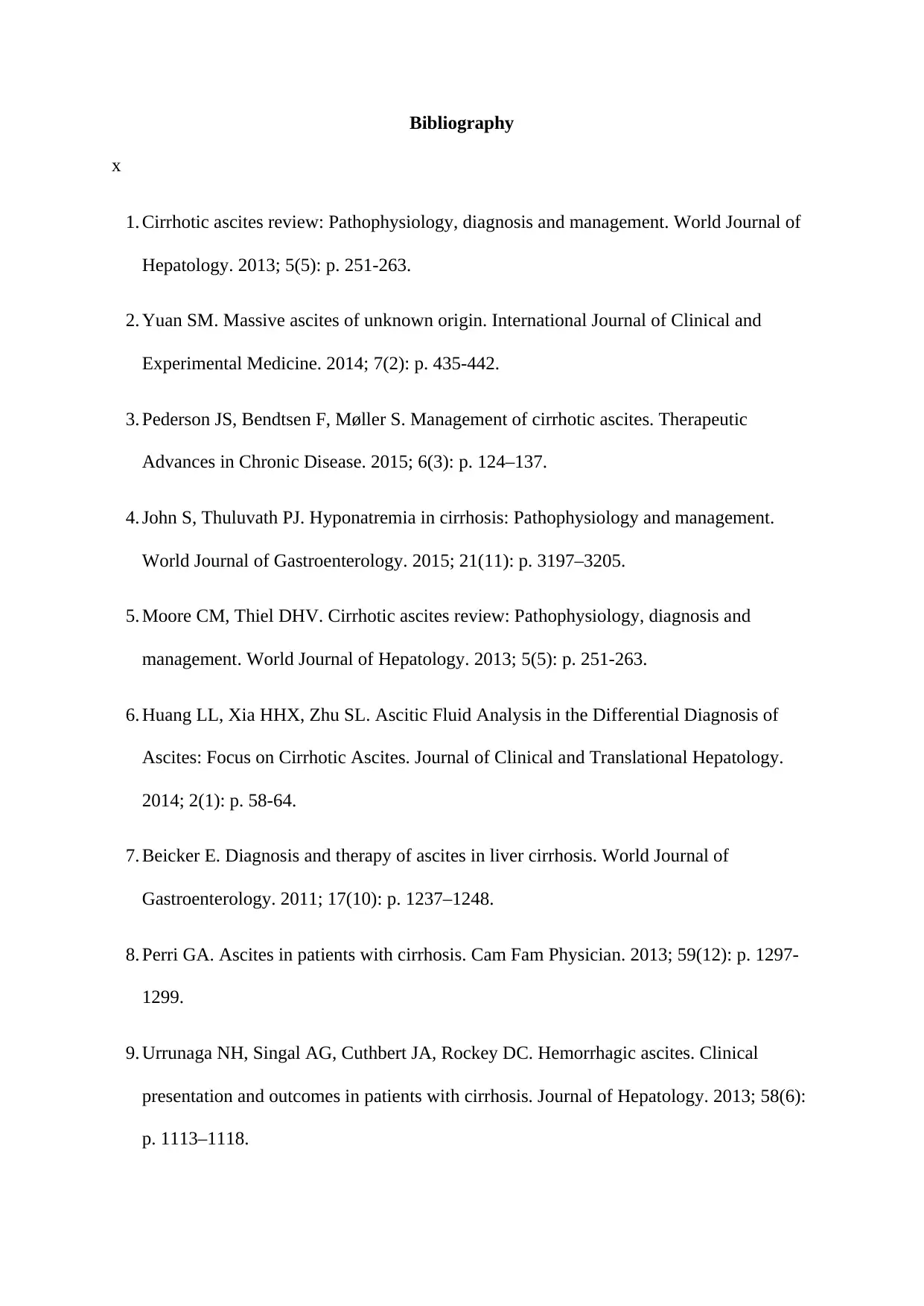
Bibliography
x
1. Cirrhotic ascites review: Pathophysiology, diagnosis and management. World Journal of
Hepatology. 2013; 5(5): p. 251-263.
2. Yuan SM. Massive ascites of unknown origin. International Journal of Clinical and
Experimental Medicine. 2014; 7(2): p. 435-442.
3. Pederson JS, Bendtsen F, Møller S. Management of cirrhotic ascites. Therapeutic
Advances in Chronic Disease. 2015; 6(3): p. 124–137.
4. John S, Thuluvath PJ. Hyponatremia in cirrhosis: Pathophysiology and management.
World Journal of Gastroenterology. 2015; 21(11): p. 3197–3205.
5. Moore CM, Thiel DHV. Cirrhotic ascites review: Pathophysiology, diagnosis and
management. World Journal of Hepatology. 2013; 5(5): p. 251-263.
6. Huang LL, Xia HHX, Zhu SL. Ascitic Fluid Analysis in the Differential Diagnosis of
Ascites: Focus on Cirrhotic Ascites. Journal of Clinical and Translational Hepatology.
2014; 2(1): p. 58-64.
7. Beicker E. Diagnosis and therapy of ascites in liver cirrhosis. World Journal of
Gastroenterology. 2011; 17(10): p. 1237–1248.
8. Perri GA. Ascites in patients with cirrhosis. Cam Fam Physician. 2013; 59(12): p. 1297-
1299.
9. Urrunaga NH, Singal AG, Cuthbert JA, Rockey DC. Hemorrhagic ascites. Clinical
presentation and outcomes in patients with cirrhosis. Journal of Hepatology. 2013; 58(6):
p. 1113–1118.
x
1. Cirrhotic ascites review: Pathophysiology, diagnosis and management. World Journal of
Hepatology. 2013; 5(5): p. 251-263.
2. Yuan SM. Massive ascites of unknown origin. International Journal of Clinical and
Experimental Medicine. 2014; 7(2): p. 435-442.
3. Pederson JS, Bendtsen F, Møller S. Management of cirrhotic ascites. Therapeutic
Advances in Chronic Disease. 2015; 6(3): p. 124–137.
4. John S, Thuluvath PJ. Hyponatremia in cirrhosis: Pathophysiology and management.
World Journal of Gastroenterology. 2015; 21(11): p. 3197–3205.
5. Moore CM, Thiel DHV. Cirrhotic ascites review: Pathophysiology, diagnosis and
management. World Journal of Hepatology. 2013; 5(5): p. 251-263.
6. Huang LL, Xia HHX, Zhu SL. Ascitic Fluid Analysis in the Differential Diagnosis of
Ascites: Focus on Cirrhotic Ascites. Journal of Clinical and Translational Hepatology.
2014; 2(1): p. 58-64.
7. Beicker E. Diagnosis and therapy of ascites in liver cirrhosis. World Journal of
Gastroenterology. 2011; 17(10): p. 1237–1248.
8. Perri GA. Ascites in patients with cirrhosis. Cam Fam Physician. 2013; 59(12): p. 1297-
1299.
9. Urrunaga NH, Singal AG, Cuthbert JA, Rockey DC. Hemorrhagic ascites. Clinical
presentation and outcomes in patients with cirrhosis. Journal of Hepatology. 2013; 58(6):
p. 1113–1118.
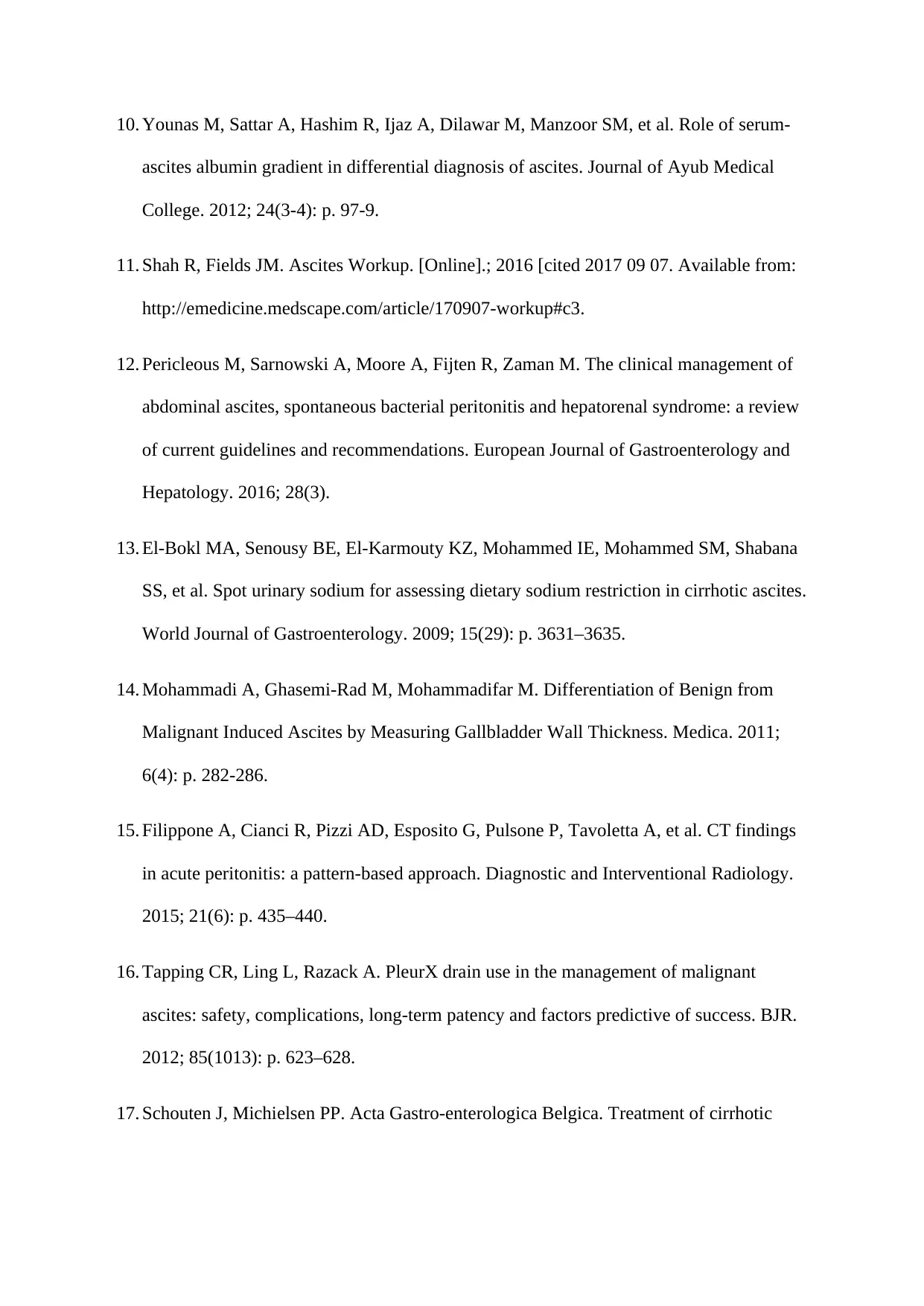
10. Younas M, Sattar A, Hashim R, Ijaz A, Dilawar M, Manzoor SM, et al. Role of serum-
ascites albumin gradient in differential diagnosis of ascites. Journal of Ayub Medical
College. 2012; 24(3-4): p. 97-9.
11. Shah R, Fields JM. Ascites Workup. [Online].; 2016 [cited 2017 09 07. Available from:
http://emedicine.medscape.com/article/170907-workup#c3.
12. Pericleous M, Sarnowski A, Moore A, Fijten R, Zaman M. The clinical management of
abdominal ascites, spontaneous bacterial peritonitis and hepatorenal syndrome: a review
of current guidelines and recommendations. European Journal of Gastroenterology and
Hepatology. 2016; 28(3).
13. El-Bokl MA, Senousy BE, El-Karmouty KZ, Mohammed IE, Mohammed SM, Shabana
SS, et al. Spot urinary sodium for assessing dietary sodium restriction in cirrhotic ascites.
World Journal of Gastroenterology. 2009; 15(29): p. 3631–3635.
14. Mohammadi A, Ghasemi-Rad M, Mohammadifar M. Differentiation of Benign from
Malignant Induced Ascites by Measuring Gallbladder Wall Thickness. Medica. 2011;
6(4): p. 282-286.
15. Filippone A, Cianci R, Pizzi AD, Esposito G, Pulsone P, Tavoletta A, et al. CT findings
in acute peritonitis: a pattern-based approach. Diagnostic and Interventional Radiology.
2015; 21(6): p. 435–440.
16. Tapping CR, Ling L, Razack A. PleurX drain use in the management of malignant
ascites: safety, complications, long-term patency and factors predictive of success. BJR.
2012; 85(1013): p. 623–628.
17. Schouten J, Michielsen PP. Acta Gastro-enterologica Belgica. Treatment of cirrhotic
ascites albumin gradient in differential diagnosis of ascites. Journal of Ayub Medical
College. 2012; 24(3-4): p. 97-9.
11. Shah R, Fields JM. Ascites Workup. [Online].; 2016 [cited 2017 09 07. Available from:
http://emedicine.medscape.com/article/170907-workup#c3.
12. Pericleous M, Sarnowski A, Moore A, Fijten R, Zaman M. The clinical management of
abdominal ascites, spontaneous bacterial peritonitis and hepatorenal syndrome: a review
of current guidelines and recommendations. European Journal of Gastroenterology and
Hepatology. 2016; 28(3).
13. El-Bokl MA, Senousy BE, El-Karmouty KZ, Mohammed IE, Mohammed SM, Shabana
SS, et al. Spot urinary sodium for assessing dietary sodium restriction in cirrhotic ascites.
World Journal of Gastroenterology. 2009; 15(29): p. 3631–3635.
14. Mohammadi A, Ghasemi-Rad M, Mohammadifar M. Differentiation of Benign from
Malignant Induced Ascites by Measuring Gallbladder Wall Thickness. Medica. 2011;
6(4): p. 282-286.
15. Filippone A, Cianci R, Pizzi AD, Esposito G, Pulsone P, Tavoletta A, et al. CT findings
in acute peritonitis: a pattern-based approach. Diagnostic and Interventional Radiology.
2015; 21(6): p. 435–440.
16. Tapping CR, Ling L, Razack A. PleurX drain use in the management of malignant
ascites: safety, complications, long-term patency and factors predictive of success. BJR.
2012; 85(1013): p. 623–628.
17. Schouten J, Michielsen PP. Acta Gastro-enterologica Belgica. Treatment of cirrhotic
⊘ This is a preview!⊘
Do you want full access?
Subscribe today to unlock all pages.

Trusted by 1+ million students worldwide
1 out of 13
Your All-in-One AI-Powered Toolkit for Academic Success.
+13062052269
info@desklib.com
Available 24*7 on WhatsApp / Email
![[object Object]](/_next/static/media/star-bottom.7253800d.svg)
Unlock your academic potential
Copyright © 2020–2025 A2Z Services. All Rights Reserved. Developed and managed by ZUCOL.


